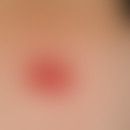HistoryThis section has been translated automatically.
Jacqueline Clarke, 1977
DefinitionThis section has been translated automatically.
Tripe palms is the name given to a very rare, paraneoplastic skin disorder that affects the palms of the hands and soles of the feet. It is characterized by thickened skin that resembles the "stomach lining" of some animals. Tripe palms occur concurrently with acanthosis nigricans "maligna" in about 7 out of 10 cases. Tripe palms are often associated with internal malignancies, thus belong to the paraneoplastic syndromes.
You might also be interested in
Occurrence/EpidemiologyThis section has been translated automatically.
Men> Women
EtiopathogenesisThis section has been translated automatically.
Elevated serum epidermal growth factor has been described in a patient with TP and bronchial carcinoma (Douglas F et al.1994). In most cases (90%), TP are associated with an underlying internal malignancy, either alone or in combination with acanthosis nigricans . The skin lesions may precede the diagnosis of primarius or develop during the disease. From the available literature, TP is associated with acanthosis nigricans in 77% of cases, whereas it occurs alone in 23% of cases.
The most common associated neoplasms are lung and gastric cancers, followed by esophagus, rectum, bronchus, urinary tract, pancreas, ovary, bile duct, thyroid, uterus, liver, kidney, and breast (Barman B et al. (2019).
Tripe palms are also associated with other non-neoplastic diseases:
- Bullous pemphigoid
- Psoriasis
- Exfoliative dermatitis.
PathophysiologyThis section has been translated automatically.
The pathogenesis of malignant AN remains unclear. One current hypothesized mechanism is the secretion of large amounts of tumor-derived growth factors, particularly transforming growth factor-α (TGF-α), which is a key cytokine that mediates epidermal cell proliferation via various growth factor receptors such as epidermal growth factor receptor or insulin-like growth factor receptor.
ClinicThis section has been translated automatically.
Typically, patients with tripe palms present with a two-dimensional thickening of the skin on the palms (palmar keratosis). The thickening often gives the skin a yellow coloration. The soles of the feet may also be affected. Furthermore, itching, multiple rapidly growing seborrheic keratoses (syndrome of Leser-Trélat) may be associated.
Differential diagnosisThis section has been translated automatically.
- Acrokeratosis paraneoplastica
- Acromegaly
- Hypertrophic pulmonary osteoarthropathy
- Pachydermoperiostosis
- Palmoplantar keratoses
- Thyroid acropathy.
Note(s)This section has been translated automatically.
There are approximately 100 cases of Tribe palms described in the medical literature.
LiteratureThis section has been translated automatically.
- Barman B et al (2019) Tripe Palms and Acanthosis Nigricans: A Clue for Diagnosis of Advanced Pancreatic Adenocarcinoma. Indian Dermatol Online J 10: 453-455.
- Abreu Velez AM et al (2010) Diagnosis and treatment of cutaneous paraneoplastic disorder. Dermatol Ther 23:662-75.
- Cohen PR et al.(1993) Tripe palms and cancer. Clin Dermatol 11:165-73.
- Chu AC et al (2016) Acquired disorders of epidermal keratinization. In: Griffiths CEM, Barker J, Bleiker T, Chalmers R, Creamer D, editors. Rook's Textbook of Dermatology. 9th ed. vol. 4. Hoboken, NJ: Wiley-Blackwell publication 87.2-87.5.
- McGinness J et al. (2006) Malignant acanthosisnigricans and tripe palms associated with pancreatic adenocarcinoma. Cutis. 78:37-40.
- Douglas F et al.(1994) Elevated levels of epidermal growth factor in a patient with tripe palms. Br J Dermatol130:686-687.
- Sinha S et al (2007) Juvenile acanthosis nigricans. J Am Acad Dermatol 57:502-508.
Disclaimer
Please ask your physician for a reliable diagnosis. This website is only meant as a reference.






